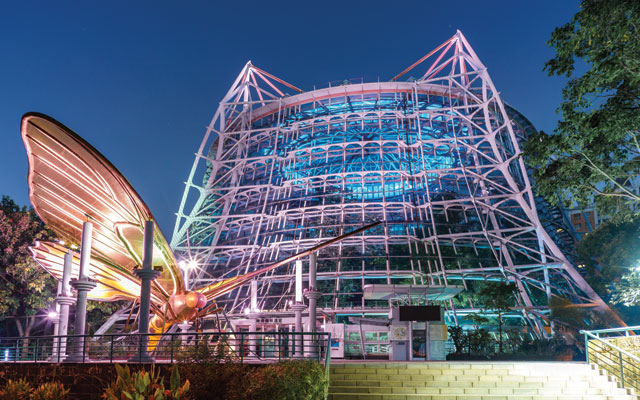Hungry for more business events, Taiwan now has a structured plan to court more markets in Asia-Pacific, reports Prudence Lui
The fifth edition of the Bureau of Foreign Trade’s four-year MICE Industry Promotion Program (Meet Taiwan), launched in January, has taken on a new approach, following much success in building Taiwan’s global reputation as a destination for business events.

In April, the Taiwan government established the New Southbound Policy for Meet Taiwan, which calls for more cooperation on investment, trade, industrial development, tourism, culture, and talent exchange with 18 countries. The countries are the 10 ASEAN members, six South Asian countries, as well as Australia and New Zealand.
Meet Taiwan’s deputy executive director, Lily Su, said the new approach was needed due to flourishing business opportunities on the back of South Asia’s population boom and emergence of outbound Muslim groups from Indonesia and Malaysia.
Meet Taiwan’s pursuit of the Muslim business events segment will gel with the country’s ongoing efforts in increasing the number of Halal-certified dining options and facilities.
Su shared that a collaborative approach will be adopted to achieve the aims of the New Southbound Policy. For instance, Meet Taiwan will forge partnerships with government agencies involved in business events in target markets and connect Taiwanese business event suppliers with Asian buyers. A clearer format of such cooperation is still being discussed, according to Su.
For the Indian market, Meet Taiwan has set its sights on the high-end, small-sized corporate incentive groups and will work on its courtship through Taiwan External Trade Development Council’s three liaison offices in Kolkata, Mumbai and Chennai.
Su explained that these three offices have extensive market experience, which will help Meet Taiwan achieve its objectives.
“We will focus on India’s stronger industries such as automobiles and IT, as they are more likely to generate (business events),” she added.
According to Su, efforts to attract these groups had started in 2016 and numbers have risen slightly. To further grow Indian business event volume, Meet Taiwan will exhibit at the Business and Luxury Travel Mart in Delhi on October 26 and 27.
For the other Asian markets covered by the New Southbound Policy, Meet Taiwan is hoping to increase corporate incentive movements especially from Thailand and Vietnam, aided by the visa-free allowance for Thai nationals and a streamlined visa application process for Vietnamese nationals.
Su believes that Taiwan has plenty to offer to South and South-east Asian travellers, who have been observed to prefer experiential activities.
“(Delegates) can experience hands-on encounters during their stay and gain distinct impressions from their visit,” she said, adding that in line with Taiwan tourism authorities’ focus on eco-tourism, a TAITRA fam trip last year had introduced a variety of eco-friendly activities such as making soap out of waste oil, experiencing local industry by visiting and working at salt pans in southern Taiwan, and creating handmade scarecrows.
At the same time, Meet Taiwan has been promoting second-tier cities like Taichung, Tainan and Taoyuan as future MICE cities. These cities have started constructing dedicated event venues and boast their own strong industries which give international planners impetus to pick them for future events. Tainan, for example, is building the Tainan Convention Centre while Taichung is renowned for manufacturing bicycles.
Meet Taiwan’s decision to expand its target markets was met with support from some local players.
Asia Concentrate Corporation’s director, Pairry Chiang, said: “It’s always good to decentralise risk, and Taiwan had relied too much on the Chinese travel market over the last few years. Since South-east Asia and South Asia are relatively new to business events compared with the West, there is hope for (business growth).”
Chiang revealed that her company “has been looking at” expanding business from South-east Asia for a long time now, and Meet Taiwan’s latest direction will enable Asia Concentrate Corporation to put its plan into action.
Aiding her and her industry peers, she said, is a competition launched by TAITRA in mid-April. Participating event companies are required to pitch a plan to promote Taiwan as an event destination, and the winner will be funded to turn the pitch into reality.
The company will host its own roadshow in the region this year, and Singapore, Malaysia, Indonesia and Thailand will be prime targets.
Chiang is also eager to bring its practice of meetings design to the new markets. She said: “Meeting design is the art of matching the form or format of a meeting to its aims. Asia Concentrate Corporation is the only organisation practising meeting design in Asia at the moment. We start doing so in 2016, in partnership with Mindmeeting from the Netherlands which has over a decade of experience.”
Commenting on the New Southbound Policy, K&A International Co. president, Kitty Wong, said for the programme to succeed, Meet Taiwan must be aware of the differences between the various markets in South Asia and South-east Asia.
“What works in Vietnam might not get you the same success in India, especially when it comes to meeting planning. It took me five years to build up K&A’s network in Thailand and Malaysia,” said Wong.





















